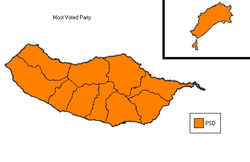1996 Madeiran regional election|
|
|
| Turnout | 65.3%  1.2 pp 1.2 pp |
|---|
|
|
First party
|
Second party
|
Third party
|
|
|
|
|
|
| Leader
|
Alberto João Jardim
|
Emanuel Fernandes
|
Rui Gomes Vieira
|
| Party
|
PSD
|
PS
|
CDS–PP
|
| Leader's seat
|
Funchal
|
Funchal
|
Funchal
|
| Last election
|
39 seats, 56.9%
|
12 seats, 22.5%
|
2 seats, 8.1%
|
| Seats won
|
41
|
13
|
2
|
| Seat change
|
 2 2
|
 1 1
|
 0 0
|
| Popular vote
|
77,365
|
33,790
|
9,950
|
| Percentage
|
56.9%
|
24.8%
|
7.3%
|
| Swing
|
 0.0 pp 0.0 pp
|
 2.3 pp 2.3 pp
|
 0.8 pp 0.8 pp
|
|
|
|
Fourth party
|
Fifth party
|
|
|
|
|
| Leader
|
Edgar Silva
|
Paulo Martins
|
| Party
|
CDU
|
UDP
|
| Leader's seat
|
Funchal
|
Funchal
|
| Last election
|
1 seat, 3.0%
|
2 seats, 4.6%
|
| Seats won
|
2
|
1
|
| Seat change
|
 1 1
|
 1 1
|
| Popular vote
|
5,495
|
5,485
|
| Percentage
|
4.0%
|
4.0%
|
| Swing
|
 1.0 pp 1.0 pp
|
 0.6 pp 0.6 pp
|
|
 The most voted party in each municipality. |
|
The Madeira Regional Election (1996) (Portuguese: Eleições Regionais da Madeira, 1996) was an election held on 13 October 1996 for the legislative assembly and government of the Portuguese autonomous region of the Madeira
The winner of the election in Madeira was, once more, the Social Democratic Party, and Alberto João Jardim was elected president of the Regional Government with an absolute majority for the 6th consecutive time. The percentage gathered by the social democrats was virtually the same of the previous election, however, due to the populational growth of the region, the number of MPs was increased from 57 to 59, and so, the social democrats gained 2 MPs, achieving a total of 41.
The People's Party lost some of its voters, but still managed to keep the 2 MPs, unlike the National Solidarity Party that lost its single MP.
On the left, the Socialist Party increased the voting by 1 percentage point and received one more MP. The Unitary Democratic Coalition, led by the Portuguese Communist Party, increased the voting and the number of MPs, stealing one MP from the People's Democratic Union that elected only 1 MP.
Voter turnout was slightly lower, compared with 1992, with 65.3 percent of the electorate casting their ballot on election day.
Electoral system
In this election, the members of the regional parliament were elected in 11 constituencies, representing the 11 municipalities of Madeira, that were awarded a determined number of member to elect according with the number of registered voters in those constituencies. The method use to elect the members was the D'Hondt method.[1] In this election the number of MPs to be elected rose from 57 in 1992 to 59.
| Constituency
|
Total
MPs
|
Registered
voters[2]
|
| Calheta
|
3
|
10,423
|
| Câmara de Lobos
|
6
|
22,321
|
| Funchal
|
28
|
96,899
|
| Machico
|
5
|
18,451
|
| Ponta do Sol
|
2
|
7,035
|
| Porto Moniz
|
1
|
3,116
|
| Porto Santo
|
1
|
3,824
|
| Ribeira Brava
|
3
|
11,147
|
| Santa Cruz
|
6
|
20,955
|
| Santana
|
2
|
8,628
|
| São Vicente
|
2
|
6,015
|
| Total
|
59
|
208,814
|
Political parties
A total of 7 political parties presented lists of candidates for the regional elections in Madeira, where 208,486 electors could elect 59 deputies to the Legislative Assembly. Of these parties, some of the more prominent:
Results
Summary of votes and seats
| Vote share |
|---|
|
|
|
| PSD |
|
56.87% |
| PS |
|
24.84% |
| CDS-PP |
|
7.31% |
| CDU |
|
4.04% |
| UDP |
|
4.03% |
| PSN |
|
0.64% |
| PDA |
|
0.42% |
| Blank/Invalid |
|
1.86% |
|
| Parliamentary seats |
|---|
|
|
|
| PSD |
|
69.49% |
| PS |
|
22.03% |
| CDS-PP |
|
3.39% |
| CDU |
|
3.39% |
| UDP |
|
1.69% |
|
Distribution by constituency
Maps
References
External links
See also